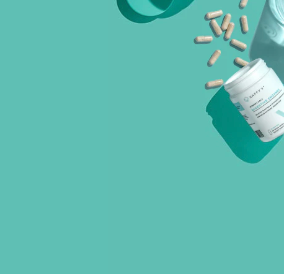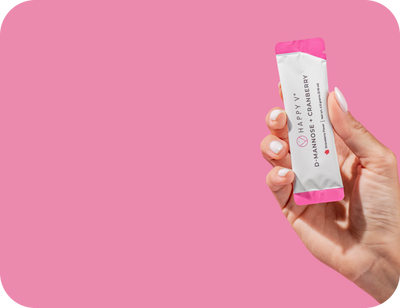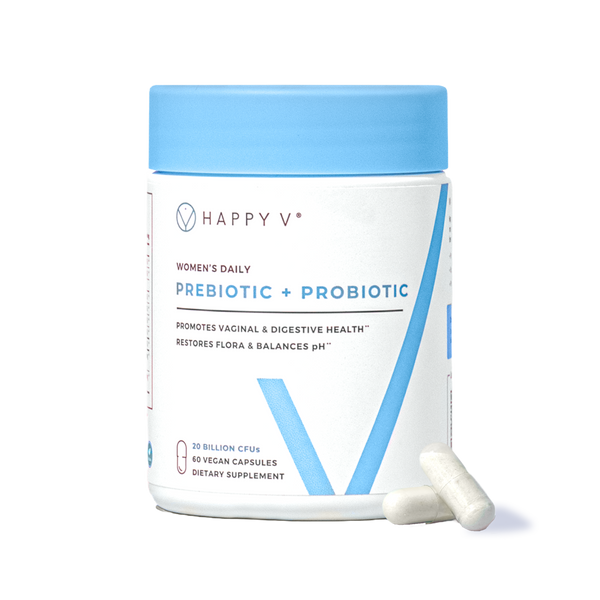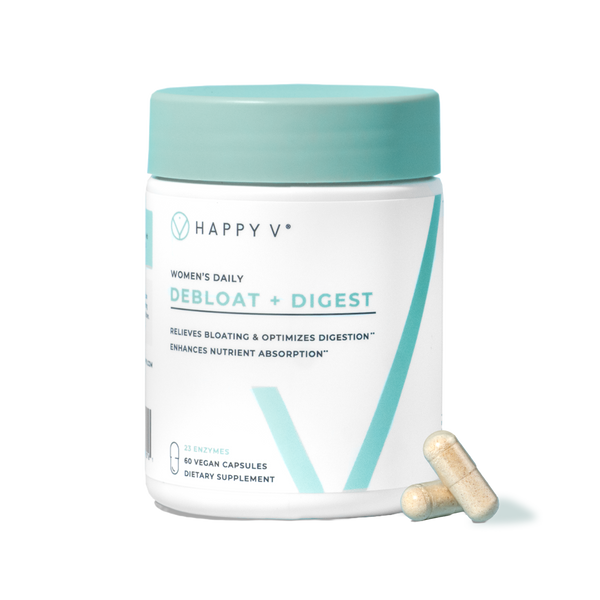- Fact Checked
- August 26, 2025
- 11 min read
What Are Vaginal Community State Types (CSTs)?
Table of Contents
Table of Contents
Your vaginal microbiome plays a big role in how you feel every day1. This community of microorganisms, including vaginal lactobacilli and other pathogens, helps protect you from unusual discharge and odor and supports immune function.
Most vaginal microbiomes fall into one of five scientifically defined profiles called Community State Types (CSTs)2. Knowing your CST gives you powerful insight into your vaginal health, like whether you're more prone to bacterial vaginosis, how your body responds to hormonal shifts, and how best to support your vaginal microbiology over time.
This post is for informational purposes only and does not constitute medical advice. See full disclaimer below.
What Are CSTs?
CST stands for Community State Type, a system that groups vaginal microbiomes based on which bacterial species are most dominant3. While the vaginal microbiome can include thousands of bacterial strains in varying amounts, CST classification simplifies this into five main profiles. This helps make complex microbiome data easier to understand, track over time, and use in both care and research.
In clinical settings, CSTs can help support diagnoses like bacterial vaginosis (BV) or aerobic vaginitis, guide treatments such as probiotic or antibiotic use, and monitor shifts across key life stages, like pregnancy, menstruation, and menopause4.
For example, CST I (dominated by Lactobacillus crispatus) is associated with a low vaginal pH and strong protection5, while CST IV (rich in anaerobic bacteria like Gardnerella vaginalis) is linked to higher rates of BV, inflammation, and STI risk.
In research and real-world care, CSTs are also used to study conditions like recurrent yeast infections, preterm birth, hormonal shifts, and to build predictive models for infection and fertility risks.
Basically, by organizing complex bacterial communities into actionable categories, CSTs help bridge the gap between microbiome science and everyday women’s health decisions.
A Quick Overview of Vaginal CSTs
Like we mentioned, there are 5 main vaginal CSTs, each defined by the general microbial composition of the vaginal microbiome6. Different CST types are more common than others, and some are more protective than others, especially when it comes to BV and STI risk.
| CST | Dominant Bacteria | pH Range | Prevalence/ Commonality | Key Health Notes |
| I | L. crispatus | ≤ 4.5 | ~20% | Most protective; low BV/STI risk |
| II | L. gasseri | 4.5–5.5 | Less common | Protective, slightly less stable |
| III | L. iners | Variable | Common | Transitional, more prone to dysbiosis |
| IV | Mixed anaerobes | >4.5 | 30–40%+ | Higher BV risk, inflammation, high diversity |
| V | L. jensenii | ≤ 4.5 | <10% | Rare but highly protective |
The Five CSTs In Detail
The above chart is helpful to compare the 5 CSTs at a glance and understand which CSTs are protective and which aren’t, but let’s also take a minute to discuss each of the CSTs in detail to fully understand their impact on your vaginal health.
CST I: Dominated by Lactobacillus crispatus
CST I is basically your vaginal microbiome’s overachiever. Dominated by L. crispatus, this CST produces both L- and D-lactic acid7, creating an acidic environment that wards off unwanted bacterial species like Gardnerella vaginalis.
CST I is linked to lower risks of bacterial vaginosis (BV)8, yeast infections9, STIs10, and even preterm birth11. Unsurprisingly, this is one of the most desirable CSTs for overall vaginal health12.
CST II: Dominated by Lactobacillus gasseri
CST II is led by L. gasseri, another lactic acid producer13. While not as robust as L. crispatus, this CST still supports a healthy vaginal pH and helps keep dysbiosis (aka an imbalance of infection-causing bacteria) at bay14.
It’s not as common as CST I, but it’s generally associated with a resilient vaginal microbiota.
CST III: Dominated by Lactobacillus iners
Now here’s where things get a bit complicated. L. iners is a bit of a wildcard. It can be part of a healthy microbiome, but it's also found in transitional or unstable states, especially post-antibiotics or during hormonal shifts15.
CST III produces only L-lactic acid and lacks other antimicrobial compounds, making it less protective overall. It’s also been associated with persistent HPV infections and bacterial vaginosis.
CST IV: Mixed Anaerobes and High Diversity
CST IV is the most diverse—and the most misunderstood. This community lacks dominant Lactobacillus spp. and instead includes anaerobic species like Gardnerella vaginalis, Atopobium vaginae, Prevotella, and Megasphaera16.
CST IV has been linked to higher vaginal pH, inflammation, and increased susceptibility to infections like BV and vaginitis.
But here’s the nuance: not all CST IV profiles are problematic17. Some contain Bifidobacterium, a more protective bacterial species. And while CST IV is more common in certain racial and ethnic groups (especially Black and Hispanic women)18, that doesn’t automatically equate to poor health. Context is everything.
CST IV Subtypes
Unlike other CSTs, CST IV contains many subtypes, including:
- IV-A: Dominated by BVAB-1 and G. vaginalis
- IV-B: High A. vaginae and G. vaginalis; often with biofilm-forming bacteria
- IV-C0: Highly diverse with Prevotella
- IV-C1: Dominated by Streptococcus; may be relevant in pregnancy
- IV-C2: Enterococcus-dominated; linked to aerobic vaginitis and UTIs
- IV-C3: Bifidobacterium-dominated; may be more stabilizing
- IV-C4: Staphylococcus-dominated; often linked to inflammation
CST V: Dominated by Lactobacillus jensenii
CST V may be rare, but it’s mighty. L. jensenii is a powerful protector, producing D-lactic acid and natural antimicrobials19.
Though less common in cross-sectional datasets, CST V has been associated with vaginal stability and lower infection risk in women’s health research.
Common Myths About Vaginal Community State Types (CSTs)
There’s a lot of confusion out there about what your CST means and what it doesn’t. Let’s clear up a few of the most common myths so you can better understand your vaginal microbiome and how to support it.
Myth 1: “All bacteria in the vagina are harmful.”
Fact: The majority of bacteria in a healthy vagina are beneficial, especially Lactobacillus species. These microbes help maintain a low pH and protect against infections20.
Myth 2: “If you don’t have vaginal symptoms, your CST doesn’t matter.”
Fact: While many women with less protective CSTs (like CST IV) don’t experience uncomfortable itching or odor, these microbiome types can still increase the risk of future issues, such as bacterial vaginosis, STIs, or complications in pregnancy. Regular monitoring is wise, even if you feel fine21.
Myth 3: “Douching or using special cleansers will improve your CST.”
Fact: Douching and harsh cleansers can actually disrupt your natural microbiome, increasing the risk of infection and shifting your CST to a less healthy state. Gentle, unscented hygiene is best22.
Myth 4: “Once you have a CST, it never changes.”
Fact: CSTs can fluctuate due to menstruation, sexual activity, antibiotics, hormonal changes, pregnancy, and menopause. Your vaginal microbiome is dynamic, not static23. Common causes for CST changes include:
- Antibiotic use: Antibiotics don’t just kill infection-causing bacteria; they can also kill the healthy bacteria that are currently dominating your vaginal microbiome and defining your CST24.
- During Pregnancy: Hormonal changes can affect your vaginal microbiome. It’s important to understand how your CST changes during pregnancy, as certain CSTs can put you at risk of preterm birth.
- Menopause: Lower estrogen levels can lead to lower levels of vaginal lactobacilli, shifting your CST.
How to Find Out Your CST: Step-by-Step
Information is power, especially when it comes to your vaginal health. Especially if you’ve struggled with uncomfortable symptoms and recurrent vaginal infections, learning your CST type can be the first step to finally finding comfort.
1. Choose a Testing Method
- Clinical Testing: Some gynecologists and clinics offer vaginal microbiome testing, often using 16S rRNA gene sequencing25.
- At-Home Test Kits: Several reputable companies provide mail-in kits. You’ll collect a vaginal swab sample in the privacy of your home.
2. Collect Your Sample
- If using an at-home test, follow the instructions carefully to ensure an accurate result. This usually means using a sterile swab and avoiding douching or sexual activity for 24 hours before sampling.
3. Send in Your Sample (At-Home Testing)
- Mail your sample to the lab using the provided packaging. Turnaround is typically 1–3 weeks.
4. Review Your Results
- Your report will show your dominant bacteria and CST type (I–V, with possible subtypes). It may also highlight your vaginal pH and the presence of any potentially disruptive microbes.
5. Consult Your Healthcare Provider
- If you received your CST report through at-home or mail-in testing, bring your results to your provider for interpretation, especially if you have symptoms or concerns. They can help you understand what your CST means for your health and next steps.
Personalized Recommendations Based on Your CST
When you bring or review your CST results with your healthcare provider, they will be able to offer personalized recommendations to improve or maintain your vaginal health. These often include:
For CST I, II, or V (Lactobacillus-Dominated): Maintain the Balance
- Continue healthy habits, like a balanced diet, gentle hygiene, and limited antibiotic use.
- Consider a daily probiotic supplement with well-studied Lactobacillus strains (like L. crispatus or L. rhamnosus) to reinforce your defenses26.
- Monitor for changes. Though you are in a protective state now, CST can change, and your body will typically let you know when something is off.
If You Have CST III (Lactobacillus iners-Dominated): Support Stability
- L. iners can coexist with both helpful and disruptive bacteria, so your microbiome may be more prone to shifts.
- Focus on stress management, a fiber-rich diet, and avoiding unnecessary vaginal products.
- Probiotics may help, but results can vary. Look for vaginal health probiotics that contain clinically studied strains, like Happy V, and discuss them with your provider before starting.
If You Have CST IV (Low-Lactobacillus, High Diversity): Be Proactive
- This CST is linked to higher pH, BV risk, and inflammation. If you aren’t experiencing symptoms now, without changes to your routine, you could experience them in the future27.
- If you’re pregnant, planning pregnancy, or have recurrent symptoms, regular monitoring is especially important.
- Avoid douching and harsh cleansers, which can make things worse.
Talk to your provider about targeted probiotics or other interventions.
How Happy V Probiotics Can Help
If you're dealing with vaginal discomfort, recurring infections, or have a less-stable CST type, probiotics can be a powerful part of your toolkit.
Happy V’s Prebiotic + Probiotic is doctor-formulated and contains only clinically studied probiotic strains like Lactobacillus rhamnosus and L. acidophilus, chosen for their ability to produce lactic acid and reduce overgrowth of microbes like Candida albicans and Gardnerella vaginalis.
Preclinical studies suggest that these strains support a shift from CST IV to more protective, Lactobacillus-dominated CSTs. They don’t treat active infections, but they can help you maintain microbial balance, especially if your CST keeps swinging in the wrong direction.
When Should You See a Healthcare Provider?
It’s important to remember that every woman’s vaginal microbiome is unique, and occasional changes in discharge, odor, or comfort are common. However, you should contact your healthcare provider if you experience any of the following:
- Persistent or strong vaginal odor
- Unusual or excessive discharge (especially if it changes color or consistency)
- Itching, burning, or irritation that doesn’t go away
- Pain during sex or urination
- Unexpected vaginal bleeding
These symptoms may indicate an imbalance in your microbiome or another health issue that requires professional assessment.
If you’re curious about your CST, experiencing recurrent infections, or considering probiotics or microbiome testing, your provider can help you interpret results and recommend the best next steps for your individual needs. Remember: while self-care is important, professional guidance is key for persistent or concerning symptoms.
Final Thoughts
Your vaginal microbiome isn’t just a passive system; it’s a thriving, changing ecosystem influenced by your hormones, habits, and health decisions. Knowing your CST is like reading your microbiome’s mood. And once you know it, you can work with it, not against it.
With education, science, and the right support, you can help your vaginal environment stay resilient, whether you're in CST I or just starting your journey from CST IV.
Keep the Conversation Going
- Visit our blog for more on improving your vaginal health.
- Join our private Happy V Facebook group to hear from others who’ve been there.
- Explore supplements designed to support your vaginal health journey.
Disclaimer: This blog is for informational and educational purposes only and is not intended to diagnose, treat, cure, or prevent any disease. Statements about supplements have not been evaluated by the Food and Drug Administration. For more information about vaginal infections, visit the CDC or speak to a licensed healthcare provider.









